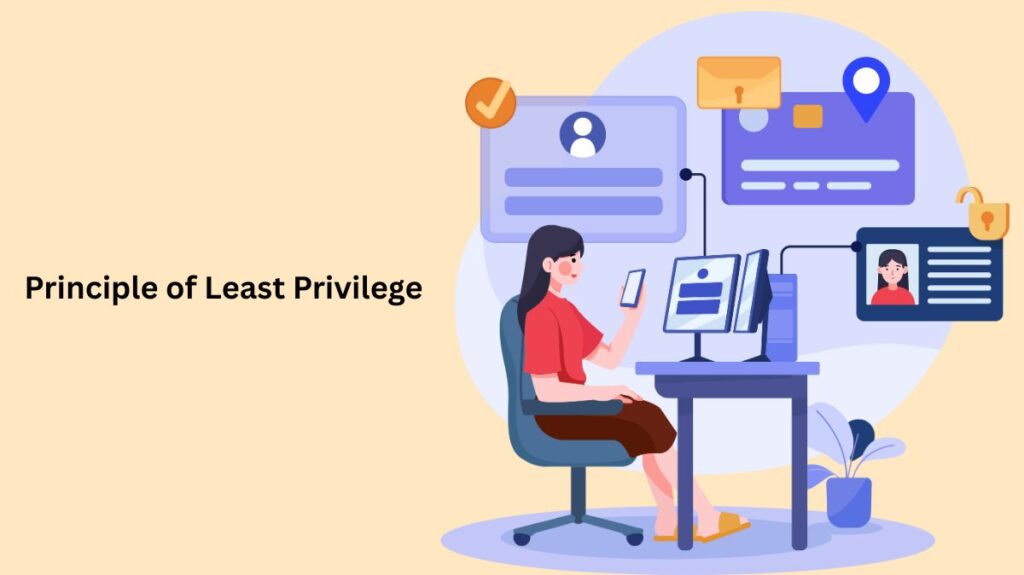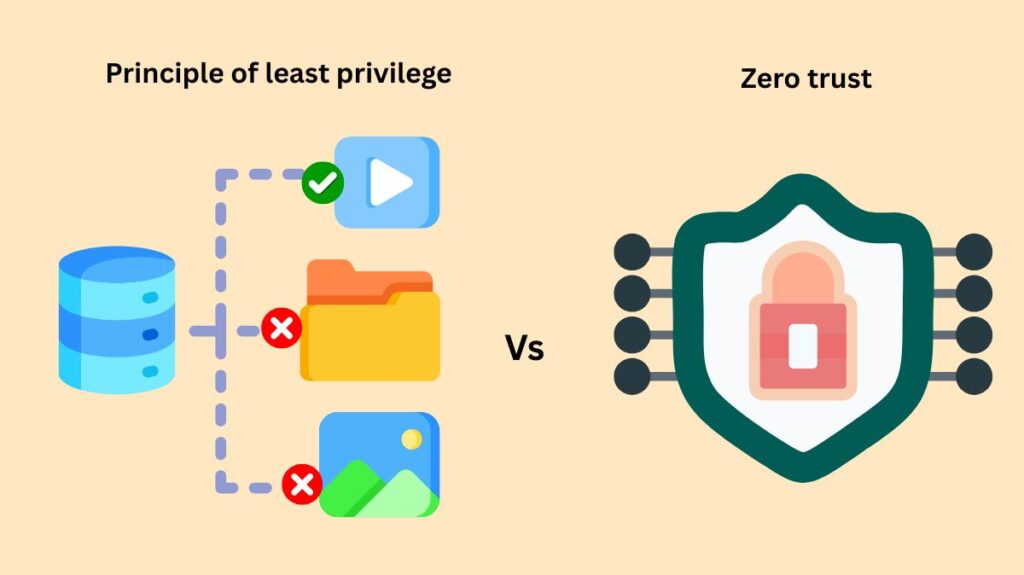We discussed the Principle of Least Privilege (POLP) in this post, including its definition and core idea, benefits of implementing the principle of least privilege, examples of application, and principle of least privilege vs Zero trust.
Principle of Least Privilege POLP
A fundamental idea in cybersecurity and information security is the Principle of Least Privilege (POLP), sometimes known as the Principle of Minimal Privilege (POMP) or the Principle of Least Authority (POLA).

Definition and Core Idea
According to the cybersecurity concept known as the Principle of Least Privilege (PoLP), users, apps, or systems should only be given the bare minimum of access rights and permissions required to carry out their assigned tasks. By lowering the potential harm from a compromised account or system, this essential security procedure helps to lower the likelihood of data breaches, illegal access, and malware proliferation. PoLP is crucial for a robust cybersecurity posture and is a fundamental part of Zero Trust Network Access (ZTNA).
“Give only what is needed, not extra” is what this simply says. The slogan “Need to Know, Need to Do” encapsulates the idea.
By restricting privileges, POLP aims to lower risk, regardless of whether the possible abuse is deliberate (by a malevolent insider) or unintentional (by a human error). Businesses can lower the risk of virus proliferation, data breaches, and unauthorised access by allowing only the most basic access privileges.
Also Read About What is Quishing, How Quishing Attacks Work and Examples
Benefits of implementing the principle of least privilege
One crucial tactic that directly addresses a number of significant security threats is the application of the Principle of Least Privilege:
Minimized Attack Surface The total number of vulnerabilities that attackers can exploit is decreased by reducing the number of possible targets and limiting access.
Containment of Breaches In the event that a system or account is penetrated, the harm is strictly restricted to the particular data or systems that the account was authorised to access, avoiding a compromise of the entire system. Rather than gaining complete control of the system, the attacker only gets limited access.
Mitigating Insider Threats By limiting superfluous authority, the principle lessens the possibility of employees accidentally or intentionally misusing resources.
Preventing Malware Propagation Many types of malware to be installed, run, or propagate, elevated or administrative privileges are necessary. Malware is frequently contained and unable to carry out harmful tasks when a user is using the least amount of privilege.
Combating Privilege Creep The steady accumulation of excessive permissions that happens when a user switches roles while keeping access rights from their prior positions is prevented by combating privilege creep, or POLP.
Regulatory Compliance Adherence to Regulations Following POLP facilitates adherence to a number of laws and guidelines, including GDPR, HIPAA, and ISO 27001.
System Stability By restricting the impact of modifications to the zone in which they are implemented, POLP enhances system stability in addition to security.
Also Read About What Is Smurf Attack Meaning? How It Works, And Prevention
Examples of Application
The idea is applicable to end users, systems, processes, and networks at all levels of an IT environment:
Users
A ordinary employee shouldn’t have administrator privileges on their computer; they should only access the apps that are necessary for their work. A typical employee should not have access to system configuration files or all employee payroll data, but they may be allowed to examine their personal files.
Applications and Procedures
Permissions to remove or alter records should not be given to a database application that merely needs to read them. In a same vein, a background process that only reads data from a certain file need to have read-only access to that file.
Networking
A visitor using Wi-Fi should only be able to browse the internet; they shouldn’t be able to access the internal company network. Using a Read-Only (ro) community string to implement the Simple Network Management Protocol (SNMP) in network security complies with POLP by minimising potential damage in the event of a compromise by enabling administrators to read only Management Information Base (MIB) variables.
Best Practices and Implementation
POLP can be difficult to execute well, particularly in large organisations, however there are a few strategies that can help:
Role-Based Access Control (RBAC)
One essential tool is Role-Based Access Control (RBAC), which defines and assigns rights according to particular job titles (such as “HR Assistant” or “Junior Developer”). This guarantees that users only inherit the permissions required for their role.
Default to Least Privilege
Higher-level privileges should only be granted as special cases, and all new user and process accounts should be created with the bare minimum of privileges by default.
Just-in-Time (JIT) Access
Enhanced access, such as administrator credentials, are only momentarily granted when necessary to finish a particular activity before being automatically withdrawn.
Frequent Auditing and Review
To avoid “privilege creep,” which is the slow buildup of superfluous powers, user privileges must be regularly reviewed and audited.
Enforce Separation of Duties
This calls for distinct individuals or accounts to carry out various steps in a crucial, high-risk procedure (for example, one person initiates a financial transaction, while another person authorises it).
Network Tools
Using explicit refuse logic, tools like as Access Control Lists (ACLs) enforce POLP in networking by by default denying all other traffic and only allowing the bare minimum of necessary protocols.
Solutions for Privileged Access Management (PAM)
These programs assist in monitoring and controlling accounts with higher levels of authority, guaranteeing strict access guidelines and auditing privileged activities.
Also Read About What is an Amplification Attack, How It Works and Prevention
Principle of least privilege Vs Zero trust

One of the fundamental elements of a Zero Trust security paradigm is the Principle of Least Privilege. By guaranteeing that, even after a user or device has been verified, they are still only given the bare minimum of access necessary for their particular task, POLP acts as the pragmatic mechanism that upholds the ideal of “never trust, always verify,” which is the foundation of a Zero Trust architecture.
| Feature | Principle of Least Privilege (PoLP) | Zero Trust (ZT) |
| Scope | A specific security principle applied to access control. | A comprehensive security model/architecture for the entire IT environment. |
| Core Philosophy | Limit the damage by ensuring every entity (user, device, process) only has the minimum permissions necessary for its function. | “Never trust, always verify” no user, device, or network location is implicitly trusted. |
| Focus | Restricting what an entity can do once access is granted. | Verifying who and what is accessing resources and under what context. |
| Access Control | Static or Role-Based: Permissions are defined by the user’s job role and are mostly static (e.g., Read/Write access to a folder). | Dynamic and Adaptive: Access is continuously evaluated based on identity, device health, location, time, and other risk factors. |
| Primary Goal | Minimize the attack surface and limit the “blast radius” (potential damage) if an account is compromised. | Prevent unauthorized access and stop lateral movement across the network. |
| Relationship | A fundamental component and prerequisite for Zero Trust. | The overarching strategy that incorporates PoLP along with other measures (like Multi-Factor Authentication, micro-segmentation, and continuous monitoring). |
Also Read About Ping of Death Attack And How To Prevent Ping Of Death Attack
